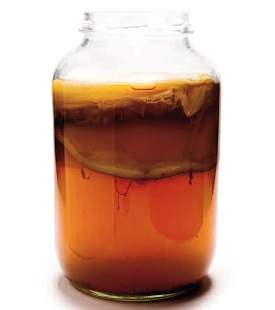Kombucha: Hooch or healer?
 GARDEN WORKS
GARDEN WORKS
by Emily Cates
Part 1 of 2
Why would anyone want to make this drink?
I must confess that, for me, writing about gardening in the dead of winter is a challenge! Faced with little willing to grow in the garden (unless it’s super-hardy veggies under cold frames), I have decided to do an article on something cultivated indoors. Now, before you get any big ideas about what that might be – just relax and try to appreciate the intriguing idea of a live-cultured (and potentially controversial) drink celebrated for centuries for its purported health benefits that probably anyone could make with a few simple ingredients found in most kitchens. Let’s do this article in two parts – this time a brief overview of what kombucha is, and reasons why people are so excited about it. Next time, we’ll look at how to make it.
Now, if you haven’t heard of it before, I would be surprised, because kombucha has recently attained a cult-like status as a “superdrink” – along with a heaping helping of hullabaloo. Go to a natural food store or even Hannaford and you’ll find a 16.2 fl. oz. bottle for three or four bucks! Needless to say, someone is making a living off this trendy beverage. Why would anyone pay that much for a drink? And if it’s so great, how could a frugal-minded person enjoy the so-called benefits of this cocktail on the cheap?
For starters, kombucha – which has been an esteemed infusion in Asia for ages – has the reputation among followers as a health tonic. Along with B-vitamins, raw kombucha is loaded with probiotics and enzymes. As it goes with many trend-setting products, kombucha has been claimed to be helpful for just about every ailment under the sun. To be fair, though, it should be noted that kombucha definitely has its share of critics in the scientific community. Please don’t interpret these articles as medical advice. I would recommend doing some thorough research if you have never tried drinking or making kombucha before you embark on a brewing escapade. Allergies and contaminations are possible, so prudence and discernment are the sensible course.

Kombucha
How does it taste? Basically a fermented black tea and sugar concoction transformed by a vinegar “mother,” plain kombucha has a typically tangy, heady flavor reminiscent of a tart molasses elixir. Home-brewed kombucha has the tendency to vary in taste and effervescence, making each batch unique in its own way. With the addition of a pinch here-and-there of something from the garden, additional layers of flavor can enhance the kombucha experience. Store-bought brands include enticing varieties such as citrus, cranberry, chai, chia, currant, chaga, bilberry, cherry, cayenne, elderberry, ginger, grape, grapefruit, guava, lavender, mango, pineapple, raspberry, and strawberry. While many of these flavors may seem exotic for our area, they give us a good idea of possible flavors we can emulate in our own brews.
So, exactly how is kombucha made? And what’s that “mother” thingy all about? The next article we’ll explore some answers to those and other questions.
Responsible journalism is hard work!
It is also expensive!
If you enjoy reading The Town Line and the good news we bring you each week, would you consider a donation to help us continue the work we’re doing?
The Town Line is a 501(c)(3) nonprofit private foundation, and all donations are tax deductible under the Internal Revenue Service code.
To help, please visit our online donation page or mail a check payable to The Town Line, PO Box 89, South China, ME 04358. Your contribution is appreciated!


Leave a Reply
Want to join the discussion?Feel free to contribute!